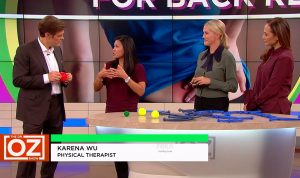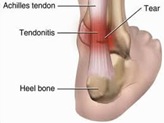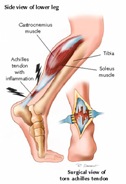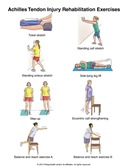 ActiveCare Physical Therapy, PC
ActiveCare Physical Therapy, PC
29 West 38th Street
Suite 601
New York, NY 10018

* We Accept Medicare | No Fault | Workers Comp *
Physical therapy for Achilles Pain
 Injury to the Achilles tendon can produce pain located in the back of the leg near the heel. The Achilles tendon connects the heel bone to the calf muscles.
Injury to the Achilles tendon can produce pain located in the back of the leg near the heel. The Achilles tendon connects the heel bone to the calf muscles.
This tendon is the primary muscle used while walking, running, and jumping and is prone to inflammation due to degeneration and overuse. Inflammation in the Achilles tendon can lead to swelling, irritation of the area, and pain for the patient as it is the body’s largest tendon.
Physical Therapy For Achilles Tendon Pain
Types of Achilles Tendinitis
There are two types of Achilles inflammation, separated by the area of the tendon that becomes inflamed.
Noninsertional Achilles tendinitis (inflammation) occurs in the middle of the tendon where muscle fibers have begun to break down. This gradual degradation occurs primarily from the tendon’s overuse, making noninsertional Achilles tendinitis a commonly seen injury for active youth.
Insertional Achilles tendinitis occurs in the lower part of the heel, where the tendon meets and attaches (inserts) inside the bone of the heel.
In both insertional and noninsertional tendinitis, the damaged Achilles tendon fibers have the potential to calcify (harden) leading to further pain felt in the heel. Bone spurs, which are extra growth of bone that form into jutting pieces, may also form. Bone spurs are seen more commonly with insertional Achilles tendinitis, mainly due to inflammation occurring in the heel bone. Insertional Achilles tendinitis can occur in any patient regardless of their activity level.
PT For Achilles Tendinitis
Physician Evaluation
After examining what symptoms presented by the patient, the physician will physically examine the foot and ankle. During examination, the physician will check for swelling on the Achilles tendon and check for a thickening or enlargement of the tendon. Bone spurs will also be examined for. The physician will make note of where pain is indicated, checking primarily the middle of the tendon and the back of the heel. The current range of motion for the ankle will also be taken, with special attention paid to any reduction in the normal range of motion.
Best PT for Achilles Pain
Other symptoms of Achilles Pain may include:
• Pain and stiffness of the tendon
• Intense pain after exercise or exertion
• Swelling that increases throughout the say
A “pop” in the heel or back of calf may indicate a rupture of the Achilles tendon and should be immediately be seen by a doctor.
Treatment for Achilles Pain
Although it seems more effective with noninsertational tendinitis, patients have found success in the elimination of Achilles pain symptoms with physical therapy. Innovative studies on new therapy techniques have been conducted by the Centre for Sports and Exercise Medicine, Queen Mary University of London, and show great promise in a full recovery of acute and chronic Achilles Tendinopathy (AT) and associated Achilles pain.
It is crucial to correctly attend to an injury with a proper treatment and physical therapy plan. Scientific evidence now supports the theory that what is many times considered an “Acute Tendinopathy” is actually an improperly healed chronic injury without histonic or biochemical inflammation that could have lifelong implications and increase in severity.
If you are experiencing Achilles pain, please contact ActveCare Physical Therapy.
